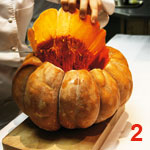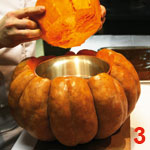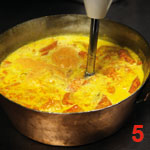Pumpkin soup with white truffle: Masterclass
Chef Guy Savoy shows how theatre in restaurants can be revived with that much-maligned ingredient, the pumpkin. Michael Raffael visited his three-Michelin-starred kitchen
Travel back 40 years to the pre-nouvelle cuisine era. Then, the grandest Parisian restaurants prepared Escoffier-inspired dishes that waiters served from the finest silverware. In the provinces, a young Paul Bocuse was dishing up regional "cuisine bourgeoise": roast Bresse chicken carved at the table by skilled waiters, sea bass in pastry, and pumpkin soup. He cut off the top of the pumpkin, scooped out the seeds, filled the cavity with cream, croûtons and Gruyère cheese and baked the whole thing in the oven for two hours.
Specialities like this vanished when plate service took over. Waiters simply delivered ready-to-eat food from the kitchen. Ladling a soup on to a plate in front of a customer became passé.
But service in the dining room is reviving, slowly. It's a reflection of the fact that all-plate service can be monotonous.
Guy Savoy has introduced pumpkin soup on this year's autumn menu at his Paris restaurant. It's a dish he has been making for parties in his private dining room for a number of years.
This, though, isn't a remake of the old Bocuse recipe. Taste and technique have moved on. It's practical, adapted to à la minute service, and it presents well. The personal touch, a liberal sprinkling of white truffles, isn't just a gimmick to bump up the price it's one of those perfect combinations, like salmon and sorrel, that turns the commonplace into something extraordinary.
Pumpkins
There are hundreds of varieties, ranging from small to Cinderella's carriage. Many are drab and tasteless, so Savoy prefers to buy sweetish ones, often classed as moschata squashes (courges or potirons musquées in French). They are botanically related to Hubbard squashes and not all varieties are round, but they have a brownish, smooth skin that divides itself naturally into segments. The pumpkins can weigh 6-7kg each, costing him about €5 (£3.92) per kg, with a pinky-orange flesh reminiscent of the best mangoes.
White truffles
At the start of this year's truffle season -September - top-quality, fresh white truffles, tuber magnatum pico, were fetching €3,500 (£2,746) per kg. That figure dips a little in the late autumn but is still scary for most chefs. Specialist Italian companies handle up to 20 separate grades depending on size and shape and damage, but the key, so far as chefs should be concerned, is freshness - truffles are a perishable commodity.
Savoy buys his direct from the number-one wholesaler and retailer in Alba, Tartufi Morra (www.tartufalba.com).
Once you've sourced them, truffles go a long way: 50g of truffle butter containing a teaspoon of shavings will flavour 10 portions. The aroma is much more complex and satisfying than most white truffle oils that contain chemical aromas and very little truffle. Even in his luxury restaurant Savoy allows only 3-4g of shaved truffle on each soup. Any more would be overkill, because too much truffle can be almost sickly in smell and ruin a dish.
On receipt of a truffle keep it refrigerated in an airtight container. Packing it in dried rice doesn't preserve it, but makes the rice smell good. Clean it only when you are ready to use it. Take a nailbrush or toothbrush, dip it in a little cold water and carefully brush off any soil or dust adhering to it (see picture below). A truffle slicer, like a mini-mandoline, is essential equipment.
Preparing a pumpkin for presentation
Ingredients
One pumpkin weighing about 6kg
Special equipment
A straight-sided, flat-based soup tureen, about 20cm diameter. At Guy Savoy it's made of silver.
Method
Rest the pumpkin on its base. Invert the tureen on top of it, keeping it centred (1).
The pumpkin divides into natural segments. Stick a knife point once into each segment, following the circumference of the tureen. Set the tureen aside.
Using a large knife inclined at an angle, cut out the top of the pumpkin following the stabs you've just made. Lift out this "lid". Slice off any seeds and straggly bits on the underside. Reserve (2).
Scoop out all the seeds from the centre of the pumpkin. Trim the inside edge so that the tureen will fit neatly in it.
Fix the tureen in place, pressing it down below the surface so that the lid will fit back snugly (3).
When filling tureen, don't put more than about 700ml of soup in it at one time, for ease of service.
The soup
Ingredients
(Makes about 1.5 litres: 10 portions)
1 x 1.25kg approx segment of ripe pumpkin
100g unsalted butter
2 large shallots (60-70g)
Salt and freshly ground pepper
500ml white chicken stock (see note 1 below)
150ml single cream
50g truffle butter (see note 2)
Note 1 White chicken stock: make a basic stock with 1kg bones and carcass, 250g carrot, onion and celery mirepoix, a bouquet garni and two litres of water. Boil, skim, simmer three hours. Strain and reduce by half. Reserve 500ml for the soup.
Note 2 Truffle butter: blend 90g unsalted butter with 10g fresh white truffle trimmings.
Method
Scrape any seeds and core from the inside of the pumpkin segment. Pare off the skin. Roughly chop the flesh into about 3cm pieces. Use about 900g.
Slice the shallots. Heat 60g butter in a large sauteuse or heavy-duty pan. Sweat the shallots, without colouring, over a low heat until they are transparent.
Add the pumpkin pieces. Season them lightly and stew them for about five minutes.
Cover them with stock. The liquid should be just over the top of the pumpkin. Simmer for 40 minutes.
Add the cream and simmer 10 minutes more (4).
Half-blend the soup with a hand mixer. Add the rest of the butter and truffle butter. Check seasoning and blend until smooth (5). It should have a rich velvety texture and the colour will be pinky-orange.
Advance preparation
You will need a tray, the hollowed-out pumpkin, a ladle, soup plate, a white truffle and truffle slicer (affetta tartufi). Pour piping-hot soup into the tureen inside the pumpkin and fit the lid.
When serving the pumpkin soup in the restaurant, either place a guéridon at the customer's table or have two waiters to serve.
Remove the lid at the table. Ladle about 150ml soup into the plate. Slice 3-4g white truffle on to the soup and serve (6).
Sommelier's choice
Sylvain Nicolas, sommelier at Guy Savoy in Paris, recommended a 2004 white Hermitage, Marc Sorrel - from about €100 (£78), if you can find it - to accompany the pumpkin soup. It's a barrel-aged north Rhône made from 100% Marsanne grapes, a rich, powerful and complex wine that will keep for up to 15 years.
The bouquet is reminiscent of almond blossom and the taste has a honeyed quality. He chose it because "it's a class act from a region with a similar climate to Piemonte that stands up well against the powerful truffle aroma, but doesn't clash with the sweet, soft flavours of the pumpkin".
Guy Savoy
In his 50s, Savoy certainly has the force with him. He can gallop up eight flights of stairs without puffing he can cycle 120km on his last holiday to Japan, he climbed Mount Fuji before dawn. Hardly surprising that his two passions are Formula 1 and rugby.
"Vitality," he claims, "helped me compensate for weaknesses in management skills when I was younger. I hadn't learnt how to handle things. Now I channel my energies much better."
Savoy is a product of the nouvelle cuisine experiment that rewrote the rule book of haute cuisine during the 1980s. While recognising certain weaknesses, he defends its positive influence on modern cooking. Until then, the dominant Parisian restaurants, such as Lassere, La Tour d'Argent, Ledoyen, Maxim's and Le Grand Véfour, all catered for a very narrow clientele.
Chefs like Paul Bocuse, the Troisgros family - where Savoy apprenticed - and Michel Guérard not only opened up culinary style, changing the approach to technique, presentation and service, they also altered the cultural landscape. Fine dining ceased to be a privilege reserved for the establishment.
The revolution that took place didn't, he feels, undermine France's right to its role as the world's dominant culinary nation. Even Ferran AdriÁ accepts that he was influenced by the NiÁ§ois chef, Jacques Maximin.
Restaurants like Guy Savoy's that reach the top of the tree can exist in numbers only because of the diversity of produce on which they depend. "The reason you find great bread in a restaurant charging €300 (£236) a head is because there are great bakers supplying them," Savoy says. "You need to be able to source a dozen varieties of apples or pears. Nowadays we have market gardeners like JoÁ«l Thiébault, who are themselves celebrities."
Savoy's bread comes from Frédéric Lalos (Meilleur Ouvrier de France). There are loaves flavoured with seaweed to accompany fish and shellfish, brittle stick-like baguettes offered with cheese, chewy rolls for the soup, sourdough and rye breads for meat and game. A warm truffled brioche accompanies an artichoke soup perfumed with truffes du Périgord and floating islands of Parmesan.
Although he plays with modern molecular tricks - a mixture of raw and cooked lobster squeaks and bubbles when dowsed in a liquid nitrogen mist - Savoy's style is rooted in the French tradition. A chestnut entrée mixes a mousse, broth and crunchy confit nuts with cèpe flakes. Crackling fish scales cover a grilled sea bass fillet. Tiny mousserons (fairy ring mushrooms) combine with mussels in a light velouté. The characteristic of his dishes is that they're garnish- and accompaniment-free. Everything forms a whole. You don't find redundant titbits decorating the plate.
A meal chez M Savoy may cost about €300 (£236) per head, but given that the restaurant opens four-and-a-half days a week and employs 47 staff, he says this is inevitable.
"My food costs range from 35% to 40%, but the main charge is staff. A junior commis earns €1,200 [£944] per month, but I have to pay as much again in social security," he says.
With three main sous chefs in the kitchen - one of whom has worked 17 years for him and the others a minimum of five - paying for skills doesn't come cheap.
Although he operates four other Parisian restaurants, Savoy spends most of his time here. "Every day I come in to work at 8.45am to talk to the chefs. At 11.45, after staff lunch, we have a briefing and I'm involved with the service, either on the pass or in the salle." He takes a break in the afternoons and stays throughout the evening.
At lunch, nine out of 10 bookings are regulars. In the evenings, Savoy has the cosmopolitan mix on which all the three-star chefs rely. This, he insists, is no longer dominated by Americans, Japanese and Europeans. "Last night there was a Korean table, a Mexican one, a Russian one and an Indian one."
Unlike some of his peers, Savoy is careful about which media commitments he accepts. "I do what pleases me - it's a privilege of my age," he says. His reasoning is simple: if he feels that a project is going to sap his vitality needlessly, he won't touch it.
Judging by the shape he's in, this is not a chef heading for premature burnout.
Photography by Lisa Barber (www.lisabarber.co.uk)
















